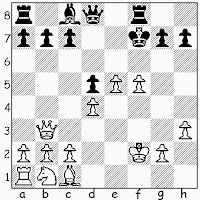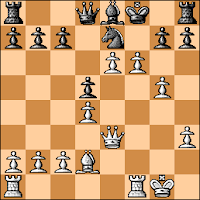
I just completed my second Jerome Gambit game in the ongoing "Italian Battleground" tournament at Chess.com. It put me very much in mind of the questions raised in the recent post "Jerome Gambit: The Eternal Question of Draws".
It felt, at first, like I was dropping 1/2 a point, but by the end of the game it appeared like I had won 1/2 a point. In any event, it is appropriate to speak well of my opponent, Krisstianes_017, whose scientific approach to defending against the opening was successful - if you call achieving a draw against a "refuted" opening a success. (Another "eternal question".)
(Although my "escape" into a drawn endgame a pawn down was very much "scientific" as well, as it involved knowledge and experience with Bishops-of-opposite-colors.)
perrypawnpusher - Krisstianes_017
"Italian Battleground", Chess.com, 2018
1.e4 e5 2.Nf3 Nc6 3.Bc4 Bc5 4.Bxf7+
4...Kxf7 5.Nxe5+ Nxe5 6.Qh5+ Ng6
The same line chosen by Abhishek29 in my other Jerome Gambit (so far) in the same tournament. For a short while I was worried that I would be playing the same game, twice.
7.Qd5+
Again, the "nudge".
7...Ke8 8.Qxc5 d6 9.Qe3 Nf6 10.O-O Be6
Black is developing his minor pieces, but this move is probably not best, as it summons the move f2-f4 (threatening a pawn fork with f4-f5) from White.
After the game, in preparing this blog post, I asked Stockfish 9 to evaluate the move 10...Be6. At a depth of 30 ply, it saw the resulting position as equal. That is worth thinking about. Should Black be happy? Should White be happy?
It is funny to note, however, that after White plays 11.f4, Stockfish 9 - again, at 30 ply analysis depth - recommends returning the Bishop with 11...Bc8!? and evaluates the result as a slight edge to Black!
I have just recently begun using version 9 of Stockfish to help me understand my completed games, and this is not the only quirky output it has provide me.
In any event, the computer prefers 10...Nh5!? (preventing f2-f4?) instead of the text.
1.e4 e5 2.Nf3 Nc6 3.Bc4 Bc5 4.Bxf7+
4...Kxf7 5.Nxe5+ Nxe5 6.Qh5+ Ng6
The same line chosen by Abhishek29 in my other Jerome Gambit (so far) in the same tournament. For a short while I was worried that I would be playing the same game, twice.
7.Qd5+
Again, the "nudge".
7...Ke8 8.Qxc5 d6 9.Qe3 Nf6 10.O-O Be6
Black is developing his minor pieces, but this move is probably not best, as it summons the move f2-f4 (threatening a pawn fork with f4-f5) from White.
After the game, in preparing this blog post, I asked Stockfish 9 to evaluate the move 10...Be6. At a depth of 30 ply, it saw the resulting position as equal. That is worth thinking about. Should Black be happy? Should White be happy?
It is funny to note, however, that after White plays 11.f4, Stockfish 9 - again, at 30 ply analysis depth - recommends returning the Bishop with 11...Bc8!? and evaluates the result as a slight edge to Black!
I have just recently begun using version 9 of Stockfish to help me understand my completed games, and this is not the only quirky output it has provide me.
In any event, the computer prefers 10...Nh5!? (preventing f2-f4?) instead of the text.
11.f4 Ne7
Interesting and good.
I faced 11...Bc4 in perrypawnpusher - avgur, blitz, FICS, 2009 (1-0, 43) as well as 11...Ng4 in perrypawnpusher - Verlen, blitz, FICS, 2010 (1-0, 23) and 11...Kd7 in perrypawnpusher - dirceu, blitz, FICS, 2010 (1-0, 16).
12.d4
Stockfish 9's recommendation is 12.f5 Bc8 13.c4 Nc6 14.d3, apparently seeing ...d7-d5 as worth preventing.
12...Kd7
Courageously planning to castle-by-hand on the queenside. I can see why my opponent would not want to strike at the center until his King was safe.
Still, the computer's suggestion is 12...d5, and I faced that move in perrypawnpusher - nmuffjgp, blitz, FICS, 2010 (1-0, 22).
13.d5 Bf7 14.c4 Kc8
15.e5
My plan was to open the center and use my "Jerome pawns" to cause havoc amongst Black's minor pieces.
Amazingly, after the game Stockfish 9 recommended the line 15.Bd2 Kb8 16.Nc3 h5 17.Rae1 a5. I was reminded of my ancient Fidelity Chess Challenger 7, that, when it assessed its King to be safe (wherever it was) and the position balanced, couldn't "think" of what to do, and so would advance its Rook pawns...
15...dxe5
This seems natural to me, but the computer doesn't like it, and prefers 15...Ng4 with an even game.
16.fxe5 Nfxd5
Again, in the post mortem Stockfish 9 had a fit with this idea. I thought it was rather "scientific" to give back the sacrificed material and leave me with an isolated pawn.






















































